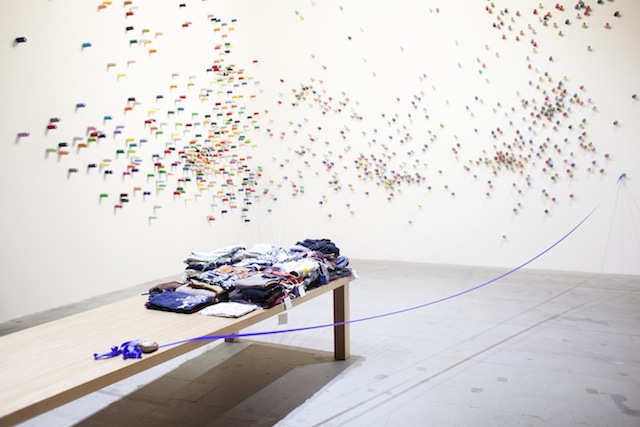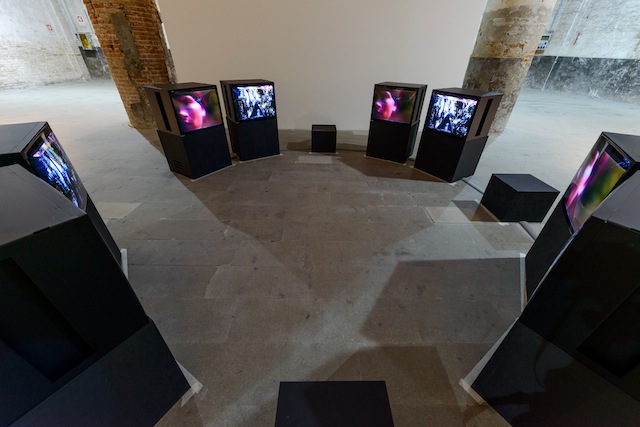The curated ‘international exhibition’ at the Venice Biennale, Christine Macel’s Viva Arte Viva, is a show that divides opinion like no other I can remember. As I walked through the Arsenale, one acquaintance I met, noting the amount of art featuring indigenous peoples, dismissed the French curator’s show as colonialist — ‘terrible’ was the blunter opinion of an American gallerist (there was no further elucidation).
It is a large show, and I’d rather let it sit and rest a little longer in my mind than come up with such a definitive statement. But what I will say is that I experienced ‘Holy Grail’ moments of ecstasy and excitement with many of the works in the exhibition, as well as where works came together. There’s a great deal of textile work in the exhibition and a great deal of art that looks to ritual and craft culture and to a diversity of world cultures and cosmological outlooks. Some would say there’s too much emphasis on this, and that they blur into one undifferentiated whole, but for me the repetition of these motifs is the point. We, humans of different cultures and histories, become woven into each other; hierarchies and borders are dispelled and innate human forces and desires are exposed by the adoption of pan-cultural modes of making and play.

Lee Mingwei, The Mending Project, 2009/2017, mixed media interactive installation, table, chairs, thread, fabric items. Image: Italo Rondinella. Courtesy La Biennale di Venezia
Lee Mingwei’s The Mending Project (2009/2016), in which visitors can bring items of clothing and other fabric items to be mended by a team of seamsters, makes this literal. We are asked to leave the items in need of repair at the exhibition, on a table; the thread used to stitch the tear or hole remains attached and spooled out from the reel attached to the gallery wall. A criss-crossing of thread thus slowly builds up, tangling and uniting the individual items to other apparel and, we poetically imagine, the lives and stories of those who brought them.
Rhythm and coming together is also at the centre of Marcos Ávila Forero’s video Atrato (2014) in which the artist, who spends part of his time in Colombia’s Amazon region, asked a group of local people to relearn the Afro-Colombian tradition of water drumming. This hotchpotch group, standing waist deep in a river, sometimes scolding each other, often laughing together, crash their hands into the water at differing speeds and strength until a deep percussive rhythm is arrived at.

Juan Downey, The Circle of Fires (El circulo de fuegos), 1979, two-channel colour video installation, sound, eight monitors, 10’. Image: Andrea Avezzù. Courtesy La Biennale di Venezia
Other moments of this weaving together, tangling ourselves into each other, are subtler. The exhibition opens in the Arsenale with two works, a series of films by Juan Downey, The Circle of Fires (El circulo de fuegos) (1979), shown on monitors in a circle, and a set of Rasheed Araeen’s Zero to Infinity for Venice, multi-coloured wood cubes (approximately 50sqcm each), which one is free to rearrange. This work revisits the artist’s earlier Zero to Infinity, first made in 1968 – an early radical example of interactivity in art and a destruction of the cool machismo minimalism that prevailed at the time. Downey’s films, which should be understood as parodies of anthropological documentary, follow various indigenous communities of the Amazon going about their everyday lives. The works are non-linear in their edit (the installation of the monitors a nod to this) and, fitting with Downey’s earlier investigations of cybernetics and utopian visions, suggest a total reimagining of consciousness, evoking the animalist philosophies of the people featured in the work.
Viva Arte Viva is utopic in intent. It occasionally lacks subtlety or complexity. Yet, artists from Europe and the United States are a distinct minority and the exhibition is unashamedly celebratory about this, and about possibilities for futures in which Western capitalist narratives and dominant Judeo-Christian worldviews recede in significance. This might be a discomforting vision to the artworlders whom exist on a New York-London-Berlin axis, but for me, it is something to applaud.
